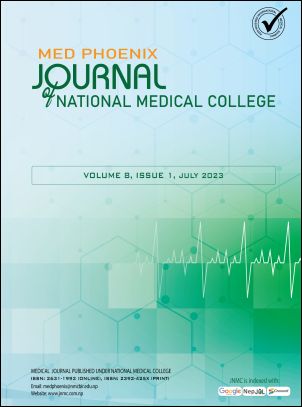Role of Ultrasonography in The Diagnosis of Knee Joint Lesions
DOI:
https://doi.org/10.3126/medphoenix.v8i1.53622Keywords:
Knee joint effusion, Knee joint pain, Osteoarthritis, Synovitis, TendinopathyAbstract
Introduction: Ultrasound can provide clinically useful information on a wide range of pathologic conditions affecting components of the knee joint, including the tendons, ligaments, muscles, synovial space, articular cartilage, nerves and surrounding soft tissues. The advantages of ultrasound include low cost, portability, real-time assessment, and facilitated side-by-side comparisons. The aim of the study was to study the various pathological conditions of painful knee joint by using ultrasound for early diagnosis and prompt therapeutic approach and to evaluate the osteoarthritic changes in the painful knee joint by ultrasound.
Materials and Methods: This is a prospective observational study conducted in the Department of Radiology and Orthopedics& trauma surgery, National Medical College & teaching hospital, Birgunj, Parsa, Nepal for the 6 months duration, patients presented with knee joint pathology including swelling, and pain.Patients included in this study was above 20 years with unilateral (single) knee joint pain. With ethical clearance from the Institutional Review Committee of National Medical College and after obtaining the informed consent of the patient, prospective observational study was conducted.
All ultrasound assessments were performed using the same machine with a 9 MHz linear transducer of GE Logiq P7 USG machine. A30–45-degree flexion of the knees was standardized by using the same wedge for all ultrasound assessments.
Results: This study included 40 symptomatic patients with knee joints pain included in this study. In 40 patients 19 were females (47.5%) and 21 males (52.5%), with ages ranged from 20 to 70 years. Ultrasound findings showed joint effusions in 25 (62.5 %) as most common finding in painful knees,synovial thickening in 17 (42.5 %) knees, Synovitis in 14 (35.0%) and tendinopathy seen in only 1 (2.5%) knee joint pain. Osteoarthritis such as narrow joint space in 4 (10%) knees, marginal osteophytes in 4 (10%) knees, loose bodies in 3 (7.5%) knees, Baker’s cyst in 1 (2.5%) knee. Most common involved age group is 51-60 years with 17 cases followed by 41-50 years in 11 cases.
Conclusion: Ultrasound is a simple and reproducible technique for the assessment of knee joint effusion, synovial changes and osteoarthritis related changes.
Downloads
Downloads
Published
How to Cite
Issue
Section
License
Copyright (c) 2023 Med Phoenix

This work is licensed under a Creative Commons Attribution 4.0 International License.
Copyright on any research article is transferred in full to MED PHOENIX upon publication. The copyright transfer includes the right to reproduce and distribute the article in any form of reproduction (printing, electronic media or any other form).
© MEDPHOENIX
![]()
Articles in the MED PHOENIX are Open Access articles published under the Creative Commons CC BY License (https://creativecommons.org/licenses/by/4.0/). This license permits use, distribution and reproduction in any medium, provided the original work is properly cited.




